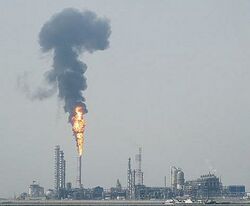DISPERSION21
DISPERSION21 (also called DISPERSION 2.1) is a local scale air pollution dispersion model[1][2][3] developed by the air quality research unit at SMHI, the Swedish Meteorological and Hydrological Institute, located in Norrköping.[4][5]
The model is widely used in Sweden by local and regional environmental agencies, various industrial users, consultant services offered by SMHI and for educational purposes.
Model description
DISPERSION21 is intended as a tool for calculating air pollutant concentrations originating from industrial or urban air pollutant sources. The model is used in studies to evaluate effects on air quality from existing or planned sources. It is a local-scale Gaussian model including plume rise and building wake effects. A street canyon component with NOx-chemistry is included.[6]
Some of the specific features and capabilities of DISPLAY21 are: [6]
- Source types: Multiple point, area , and volume sources as well as street canyons.
- Source releases: Surface, near surface and elevated sources.
- Source locations: Urban or rural locations.
- Plume types: Continuous or intermittent buoyant plumes
- Plume dispersion treatment: Gaussian model treatment using Green's functions and includes multiple reflections.
- Terrain types: Simple terrain with no more than 10 degree slopes.
- Building effects: Building downwash algorithms are included.
- Meteorological data: The model includes a preprocessor to produce the meteorological parameters needed to characterize the atmospheric turbulence as well as to produce wind speed and direction profiles.
- The street canyon module includes some atmospheric chemistry for photochemical reactions.
The meteorological preprocessor and the point source part of the model have been extensively evaluated against many datasets. The street canyon part of the model has been tested with highway data. The model has also been tested in extremely stable atmospheric situations with datasets from Lycksele in Sweden.[6][7]
Ongoing modifications
As of June 2011, SMHI is adapting DISPERSION21 so as to fit into their two overall air quality and dispersion modeling systems known as SIMAIR and Airviro. The adaptation is currently ongoing and the latest version of DISPERSION21 is referred to DISPERSION21-beta.[8]
References
- ↑ D.B. Turner (1994). Workbook of Atmospheric Dispersion Estimates, 2nd Edition. CRC Press. ISBN 1-56670-023-X. www.crcpress.com
- ↑ Karl B. Schnelle and Partha R. Dey (2000). Atmospheric Dispersion Modeling Compliance Guide, 1st Edition. McGraw-Hill Professional. ISBN 0-07-058059-6. Available online at Google Books
- ↑ Beychok, Milton R. (2005). Fundamentals of Stack Gas Dispersion, 4th Edition. author-published. ISBN 0-9644588-0-2. www.air-dispersion.com
- ↑ Air Quality Research staff and contacts From the SMHI website
- ↑ Gunnar Omstedt (August 1988), An operational air pollution model, SMHI Report RMK 57
- ↑ 6.0 6.1 6.2 MDS - Model Documentation System From the website of the European Environment Information and Observation Network (EIONET)
- ↑ Air Quality Dispersion Modelling of Wood Smoke Emissions in Residential Areas in Sweden Gunnar Omstedt, Christer Johansson and Lars Gidhagen (June 2004), SMHI, 19th International Conference on Harmonisation within Atmospheric Dispersion Modelling for Regulatory Purposes.
- ↑ Personal communication by email dated May 29, 2011 from Hans Backström, the air quality product manager at SMHI.
